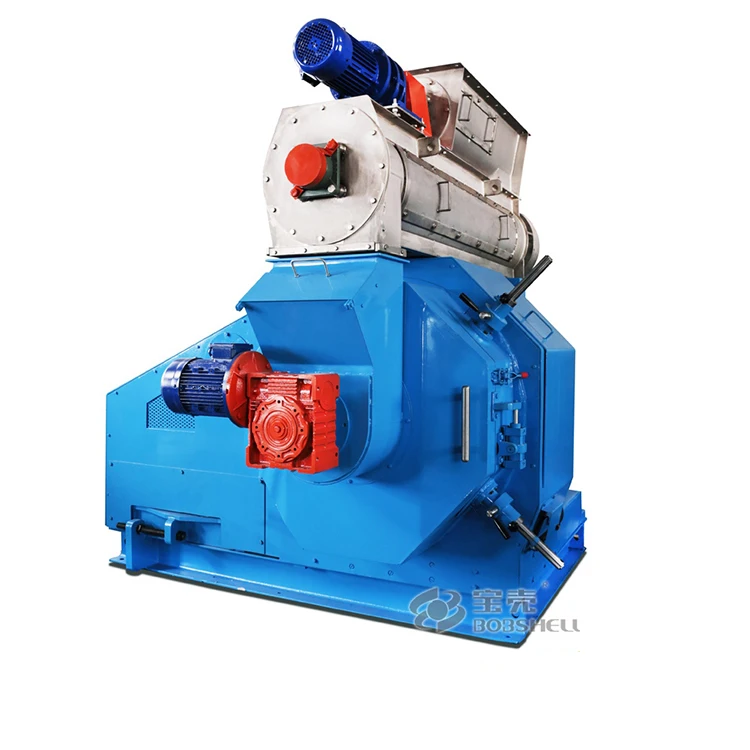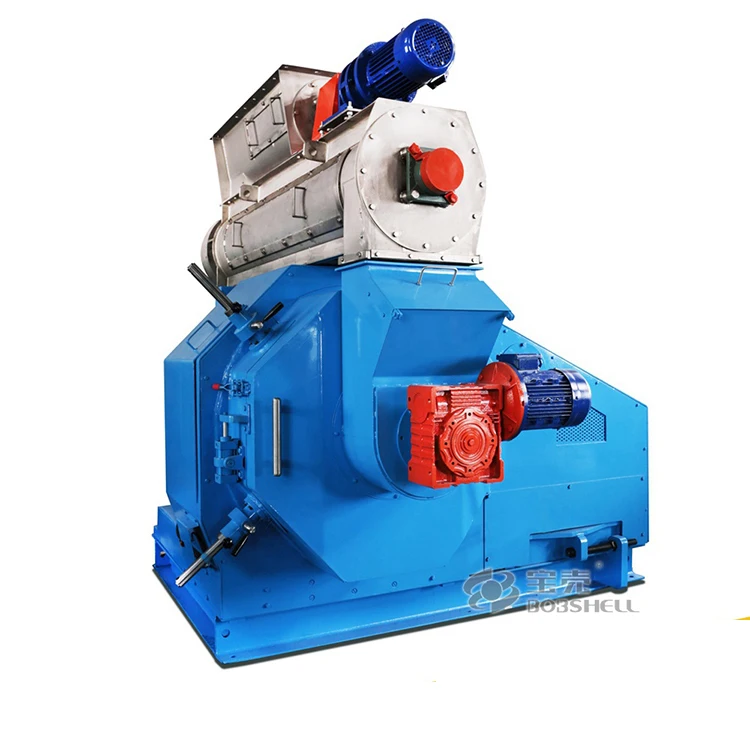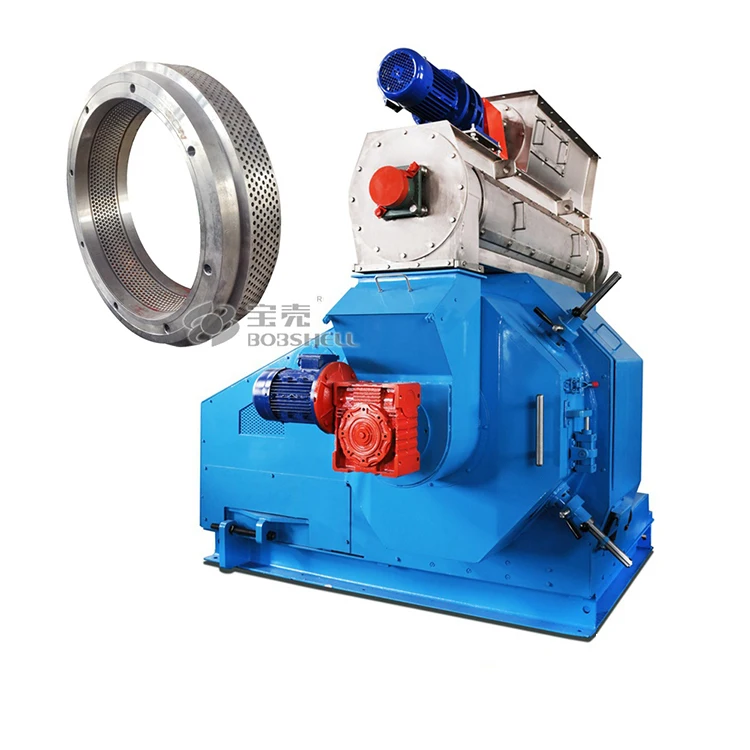Producing wood pellets,animal feeds pellets and other pellets
MOQ: 1 pcs
Delivery time:10 to 30 days after receipt of the advance payment
The entire machine is guaranteed fo r 3 years, except fo r easily worn parts.
Ring die: Working life of bloenergy pellets be 1000 hours, Working life of animal feed pellets be 1500 hours.
All steel from top tier factories will be used
Compliant with GB/T 19001-2016/ISO 9001:2015
The factory covers an area of over 13000 square meters and has two large production workshops and a comprehensive warehouse.
Bobshell MH-2000(520)Bioenergy pellet machine,Supported by Italian Bioenery pellet machine technology of 50 years,High-efficiency Steady Low maintenance cost,More than 10 years working life.
| Product name | poultry feed pellet mill machine |
| Keyword | flat dies for pellet mills,fuel pellet mill,large pellet mill machine,food pellet mill,pellet mill ring die,sawdust pellet mill product,wood pellet mill equipment,shrimp feed pellet mill |
| Place of Origin | China |
| Rated production capacity | 1134-2000Kgs/H |
| Pellet diameters | 5-12mm |
| Motor power | 160KW(220HP) |
| Screw feeder Diameter | 207mm |
| Invention patent(Ring die wood chip granulator): | ZL 2015 1 0365726. X |
| Ring Die Inner diameter | 520mm |
| Working width | 82mm |
| Working area | 13.39Cubic dm |
| Feature | Supported by Italian Bioenery pellet machine technology of 50 years,High-efficiency Steady Low maintenance cost,More than 10 years working life.. |
| Machine size | 3440mm*2336mm*2363mm, (Contact us for specific information to confirm) |
| Applicable Industries | medium-sized aquaculture,, etc. |
| Color | pink |
| Weight | 5602kg |
| terms of paymen | Cash,T/T,T/L. |
| Life span | 12 years (Contact us for specific information to confirm) |
| After-sale service | The entire machine is guaranteed for 3 years, except for easily worn parts. |
| poultry feed pellet mill machine Advantage | We keep good quality and competitive price to ensure our customers benefit |
| Packing | 3557x2974x2785mm(Contact us for specific information to confirm) |
| Sales country | All over the world for example:Ghana,Slovakia,Israel,Guernsey,Zimbabwe,Nicaragua,Senegal |
| MOQ | 4pcs(Contact us for specific information to confirm) |
Delivery time | 10 to 30 days after receipt of the advance payment |



poultry feed pellet mill machine
as one of the most professional poultry feed pellet mill machine manufacturer has the advantages at:
The company's BOBSHELL brand serial products have accumulated served over 1200 clients around the world and be long-lasting reliable supplier of GF, LA MECCANICA, CPM, BUHLER, ANDRITZ which are world famous firms in Pellet industry.
Hongxing Machinery insists on the mission of "World class quality,serve Chinese clients to expand the markets."Bobshell" parts have gained huge competition advantages in the fields of animal feeds,biomass fuels,chemicals, organic fertilizers etc.
poultry feed pellet mill machine services FAQs Guide
Are you looking for a quick review guide about poultry feed pellet mill machineservices?
An ultimate FAQ buying guide is available to help you.This guide contains all the information about all the important facts, figures, and various processes regarding poultry feed pellet mill machine services.
Let’s continue!
1.What are the key components of a high-quality poultry feed pellet mill machine?
We continue to improve poultry feed pellet mill machine products and processes to improve efficiency.
1. Robust frame and structure: A high-quality pellet mill should have a strong and durable frame and structure to withstand the high pressure and force during the pelletizing process.
2. Efficient motor: The motor is the heart of a pellet mill and should be powerful enough to handle the workload and maintain a consistent speed.
3. Die and rollers: The die and rollers are crucial components that shape the pellets and determine their quality. They should be made of high-quality materials and have a precise design to ensure consistent and uniform pellets.
4. Feeder and conditioner: The feeder and conditioner are responsible for regulating the flow of raw materials and adding moisture to the mixture, respectively. They should be designed to work efficiently and evenly distribute the materials.
5. Control system: A high-quality pellet mill should have a reliable control system that allows for precise adjustments and monitoring of the pelletizing process.
6. Cooling system: A cooling system is essential to prevent the pellets from overheating and maintain their quality. It should be designed to cool the pellets quickly and evenly.
2.How does the cost of a poultry feed pellet mill machine compare to other forms of biomass conversion equipment?
We have broad development space in domestic and foreign markets. poultry feed pellet mill machine have great advantages in terms of price, quality, and delivery date.
The cost of a pellet mill can vary depending on the size and capacity of the equipment, but generally it is more expensive than other forms of biomass conversion equipment such as briquetting machines or gasifiers. This is because pellet mills require more complex machinery and processes to produce high-quality pellets. Additionally, the cost of raw materials for pellets, such as wood or agricultural waste, can also impact the overall cost of operating a pellet mill. However, pellet mills have the advantage of producing a more uniform and compact fuel source, making them more efficient and cost-effective in the long run.

3.How can a poultry feed pellet mill machine help reduce reliance on fossil fuels?
We maintain a stable growth through reasonable capital operations, focus on industry development trends and cutting -edge technologies, and focus on product quality and safety performance.
A pellet mill can help reduce reliance on fossil fuels in several ways:
1. Producing renewable energy: Pellet mills can produce biomass pellets from organic materials such as wood, agricultural waste, and energy crops. These pellets can then be used as a renewable energy source, reducing the need for fossil fuels.
2. Replacing traditional fuels: Biomass pellets can be used as a direct replacement for traditional fuels such as coal, oil, and natural gas. This reduces the demand for these non-renewable resources and decreases reliance on fossil fuels.
3. Lowering carbon emissions: Burning biomass pellets produces significantly lower carbon emissions compared to fossil fuels. This helps to reduce the overall carbon footprint and combat climate change.
4. Promoting sustainable practices: Pellet mills encourage the use of sustainable practices such as reforestation and crop rotation, which can help to reduce the reliance on fossil fuels in the long term.
5. Providing a local energy source: Pellet mills can be set up in local communities, providing a source of energy that is produced and used locally. This reduces the need for long-distance transportation of fossil fuels, further reducing reliance on them.
4.How does the market demand for pellets affect the poultry feed pellet mill machine industry?
We should have a stable supply chain and logistics capabilities, and provide customers with high -quality, low -priced poultry feed pellet mill machine products.
The market demand for pellets has a significant impact on the pellet mill industry. As the demand for pellets increases, the demand for pellet mills also increases. This is because pellet mills are the primary equipment used to produce pellets, and as demand for pellets grows, more mills are needed to meet the demand.
The market demand for pellets also affects the pricing of pellet mills. When demand is high, the prices of pellet mills tend to increase due to the limited supply and high demand. On the other hand, when demand is low, the prices of pellet mills may decrease as manufacturers try to attract customers and stimulate demand.
Moreover, the market demand for pellets also drives innovation and technological advancements in the pellet mill industry. As the demand for pellets grows, manufacturers are motivated to develop more efficient and advanced pellet mills to increase production and meet the demand.
Overall, the market demand for pellets plays a crucial role in the growth and development of the pellet mill industry, influencing production, pricing, and innovation.

5.What are the cost-saving benefits of using a poultry feed pellet mill machine?
Being one of the top poultry feed pellet mill machine manufacturers in China, We attach great importance to this detail.
1. Lower fuel costs: Pellet mills use biomass materials such as wood chips, sawdust, and agricultural waste as fuel, which are often cheaper than traditional fossil fuels like oil or gas.
2. Reduced transportation costs: Pellet mills can be set up near the source of biomass materials, reducing the need for transportation and associated costs.
3. Increased efficiency: Pellet mills have a high efficiency rate, meaning they can produce more pellets with less material, resulting in cost savings.
4. Minimal maintenance costs: Pellet mills are designed to be durable and require minimal maintenance, reducing the need for costly repairs or replacements.
5. Reduced waste disposal costs: Pellet mills can process waste materials, such as sawdust or agricultural waste, into useful pellets, reducing the need for costly waste disposal methods.
6. Tax incentives: In some countries, there are tax incentives for using renewable energy sources like biomass, making pellet mills a cost-effective option.
7. Long-term cost savings: Investing in a pellet mill can result in long-term cost savings as it reduces the reliance on expensive fossil fuels and provides a sustainable energy source.
8. Versatility: Pellet mills can produce a variety of pellets for different purposes, such as heating, cooking, and animal feed, providing cost savings for multiple uses.
6.What are the best practices for storage and handling of pellets produced by a poultry feed pellet mill machine?
We have a first -class management team, and we pay attention to teamwork to achieve common goals.
1. Proper Storage: Pellets should be stored in a dry, cool, and well-ventilated area to prevent moisture absorption and mold growth. They should also be protected from direct sunlight and extreme temperatures.
2. Use Appropriate Containers: Pellets should be stored in airtight containers such as plastic bags or sealed bins to prevent exposure to air and moisture.
3. Regular Inspection: Regularly inspect the storage area and containers for any signs of damage or contamination. Any damaged or contaminated pellets should be removed immediately to prevent further damage.
4. Avoid Contamination: Keep the storage area clean and free from any potential contaminants such as dust, insects, or rodents. This can be achieved by regularly cleaning the storage area and using pest control measures.
5. Proper Handling: When handling pellets, it is important to use appropriate equipment such as forklifts or pallet jacks to avoid damage to the pellets. Avoid dropping or throwing the pellets as this can cause breakage and affect their quality.
6. Rotate Stock: To ensure the freshness and quality of the pellets, it is important to rotate the stock and use the oldest pellets first.

7.What are the safety considerations when operating a poultry feed pellet mill machine?
We have established long-term and stable partnerships with our suppliers, so we have great advantages in price and cost and quality assurance.
1. Proper Training: It is important to receive proper training on how to operate a pellet mill before using it. This will ensure that you know how to use the machine safely and effectively.
2. Wear Protective Gear: When operating a pellet mill, it is important to wear appropriate protective gear such as safety glasses, gloves, and earplugs. This will protect you from any potential hazards or accidents.
3. Keep Hands and Clothing Clear: Make sure to keep your hands and clothing clear of the pellet mill while it is in operation. Loose clothing or jewelry can get caught in the machine and cause injury.
4. Regular Maintenance: Regularly inspect and maintain the pellet mill to ensure it is in good working condition. This will help prevent any malfunctions or accidents.
5. Follow Manufacturer's Instructions: Always follow the manufacturer's instructions for operating the pellet mill. This will ensure that you are using the machine correctly and safely.
8.Can a poultry feed pellet mill machine be used for both commercial and personal use?
We continuously upgrade our skills and knowledge to adapt to changing poultry feed pellet mill machine market needs.
Yes, a pellet mill can be used for both commercial and personal use. Pellet mills are versatile machines that can produce a variety of pellets, such as wood, feed, and biomass pellets. They are commonly used in commercial settings, such as large-scale farms and industrial plants, to produce pellets for animal feed or fuel. However, they can also be used for personal use, such as in small-scale farms or backyard gardens, to produce pellets for personal consumption or to sell to local markets. With the increasing demand for sustainable and renewable energy sources, pellet mills are becoming popular for personal use as they provide a cost-effective and eco-friendly way to produce pellets from various materials.

9.What are the advantages of using a poultry feed pellet mill machine over traditional heating methods?
As one of the top poultry feed pellet mill machine manufacturers in China, we take this very seriously.
1. Cost-effective: Pellet mills use biomass materials such as wood, sawdust, and agricultural waste, which are often cheaper than traditional heating fuels like oil and gas. This makes pellet heating a more cost-effective option in the long run.
2. Renewable energy source: Pellet mills use renewable biomass materials, making them a more sustainable and environmentally friendly heating option compared to fossil fuels.
3. Efficient combustion: Pellet mills produce high-quality pellets that burn efficiently and cleanly, resulting in less ash and emissions. This makes them a more efficient heating method compared to traditional stoves or fireplaces.
4. Easy to use: Pellet stoves and boilers are easy to operate and require minimal maintenance. They also have automatic ignition and temperature control, making them convenient and user-friendly
.
5. Consistent heat output: Pellet mills produce uniform and consistent pellets, ensuring a steady heat output. This is not always the case with traditional heating methods, which can result in fluctuating temperatures.
6. Versatile: Pellet mills can be used for a variety of heating needs, from residential homes to large commercial buildings. They can also be used for heating water and generating electricity.
7. Space-saving: Pellet stoves and boilers are compact and can be installed in small spaces, making them ideal for homes with limited space.
8. Reduced carbon footprint: Using pellet mills for heating reduces the carbon footprint and helps combat climate change. This is because biomass materials used in pellets are carbon neutral, meaning they do not contribute to greenhouse gas emissions.
9. Government incentives: In many countries, there are government incentives and tax credits available for using renewable energy sources like pellet mills, making them a more attractive option for homeowners.
10. Long-term investment: While the initial cost of purchasing and installing a pellet mill may be higher than traditional heating methods, it is a long-term investment that can save money on heating costs in the future.
10.Is a poultry feed pellet mill machine more efficient than other forms of biomass conversion?
We pay attention to the transformation of intellectual property protection and innovation achievements. Your OEM or ODM order design we have a complete confidentiality system.
Yes, a pellet mill is more efficient than other forms of biomass conversion. This is because pellet mills use a compacting process to compress biomass materials into dense pellets, which makes them easier to transport and store. This compacting process also increases the energy density of the pellets, making them more efficient to burn for energy production. Additionally, pellet mills have a higher conversion rate compared to other forms of biomass conversion, meaning that a larger percentage of the biomass material is converted into usable energy. This makes pellet mills a more sustainable and cost-effective option for biomass conversion.

11.What are the factors to consider when choosing a poultry feed pellet mill machine for specific needs?
We are a professional poultry feed pellet mill machine company dedicated to providing high quality products and services.
1. Production Capacity: The first factor to consider when choosing a pellet mill is the production capacity required for your specific needs. This will depend on the amount of pellets you need to produce per hour or per day.
2. Pellet Size and Shape: Different pellet mills are designed to produce different sizes and shapes of pellets. Consider the size and shape of pellets required for your specific needs and choose a pellet mill that can produce them.
3. Power Source: Pellet mills can be powered by electricity, diesel, or gasoline. Consider the availability and cost of these power sources in your area when choosing a pellet mill.
4. Pellet Quality: The quality of pellets produced by a pellet mill is crucial, especially if they are used for animal feed or heating. Look for a pellet mill that produces high-quality pellets with minimal fines.
5. Maintenance and Durability: A pellet mill is a significant investment, and you want to choose one that is durable and requires minimal maintenance. Consider the materials used in its construction and the availability of spare parts.
Tag:the mini pellet mill,wool pellet mill,flat dies for pellet mills,ring die pellet mill design,self contained pellet mill,pellet mill manufacturers,large wood pellet mill,rice straw pellet mill
Copyright © Zhangjiakou Hongxing Machinery Co., Ltd. All Rights Reserved